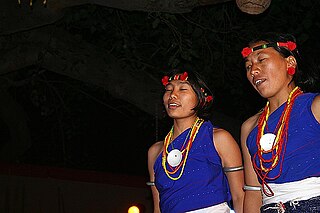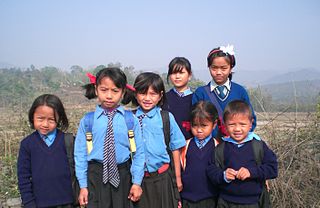Related Research Articles

Nagaland is a landlocked state in the north-eastern region of India. It is bordered by the Indian states of Arunachal Pradesh to the north, Assam to the west, Manipur to the south, and the Naga Self-Administered Zone of the Sagaing Region of Myanmar (Burma) to the east. Its capital city is Kohima and its largest city is the twin Chümoukedima–Dimapur. The state has an area of 16,579 square kilometres (6,401 sq mi) with a population of 1,980,602 as per the 2011 Census of India, making it one of the smallest states of India.
The Aos are a major Naga ethnic group native to Mokokchung District of Nagaland in Northeast India. Their main territory is from Tsüla (Dikhu) Valley in the east to Tsürang (Disai) Valley in the west in Mokokchung District.

Phek District (pron:/ˈfɛk/) is a district in the Indian state of Nagaland. At 2,026 square kilometres (782 sq mi), the district is the seventh-most populous district in Nagaland and 596th most populous district in India with 163,418 inhabitants. The district is home to 8.26% population of Nagaland. The district headquarter is located at Phek, 120 kilometres from Kohima, the capital of Nagaland and the largest urban centre is Pfütsero.

The Konyaks are a major Naga ethnic group native to the Northeast Indian state of Nagaland. They inhabit the Mon District, which is also known as The Land of the Anghs. The Anghs/Wangs are their traditional chiefs whom they hold in high esteem. Facial tattoos were earned for taking an enemy's head.
The Sangtams are a Naga ethnic group native to the Kiphire District in the Northeast Indian state of Nagaland.
Naga cuisine is the traditional foods of the Naga people in the northeastern region of India and northwestern region of Myanmar. Each ethnic group of the Nagas prepares its own unique style of cuisines. It most notably features rice, meats and leaf vegetables. Meat prepared by the Nagas are often smoked, dried or fermented.
The Rengma Naga are a Tibeto-Burman ethnic group inhabiting the Northeast Indian states of Nagaland and Assam. According to the 2011 Census of India, the population of Rengmas in Nagaland stands at 62,951 and the population of Rengmas in Assam is around 22,000. Tseminyü District is the headquarters of the Rengmas in Nagaland and the headquarters of the Rengmas in Assam is located at Phentsero/Karenga Village.
The Lothas, also known as Kyongs are a major Naga ethnic group native to Wokha District in the Northeast Indian state of Nagaland.
Sakraba is a village of the Chakhesang tribe located in the Phek district of Nagaland in northeastern India. The village is 12 kilometers away from Pfütsero. The people of Sakraba speak the Chokri language. Ethnically, Sakraba is a Chokri village. It is bounded by the Zanübou range and Pholami village in the north, Gidemi village & Chizami Town in the east, Chizami village in the south and Porba village in the west. The endangered Tragopan bird is found in the Zanübou ranges. Apart from varieties of flora and fauna, medicinal plants like ginseng are also found here.
Chokri, is one of three languages spoken by the Chakhesang Naga of Phek district, Nagaland state, India. There are also some Chokri speakers residing in the Senapati District of Manipur. In 1991, it was estimated that there were 20,000 native Chokri speakers.
The Mao people are a Tibeto-Burman major ethnic group constituting the Nagas inhabiting the northern part of Manipur and some parts of Nagaland in Northeast India.
Medziphema is a town and sub-division located in Chümoukedima District of Nagaland state of India. Medziphema Town and Medziphema Village are situated few kilometers apart, the village stands on a hill top to the north of the near-valley Town. It is located 44 km from the Capital City of Kohima, 20 km from Chümoukedima and 33 km from Dimapur. The National Highway 29 runs through the Town area.

The Yimkhiungs are a Naga ethnic group inhabiting the territories of Shamator and Kiphire District in the Northeast Indian state of Nagaland and western areas of Myanmar.
Kuzha or Khezha, is a major language of the Chakhesang Naga ethnic group of Phek District in the southern part of Nagaland, India. It is generally spoken by the Kuzhami people and is one of the three major languages of the Chakhesang Nagas. Khezha or Kuzhale is predominantly spoken in Pfütsero and Chizami region of Phek District. It is also spoken by few villages in the northern part of Ukhrul District in the state of Manipur. It also shares a high lexical similarity with the Mao Language and Paomai Language. This intelligibility has been however, reduced due to Chokri and Pochuric influences.

Tetseo Sisters are a quartet of sisters from the Northeast Indian state of Nagaland. They are devoted to the art and tradition of the vocal folk music of the state and have been performing on stage since they were children.

The Pochurys are a Naga ethnic group inhabiting the Northeast Indian state of Nagaland. They mostly live in the eastern part of the Phek district, centered at Meluri town.
Khezhakeno is a village in the Phek District of the Indian state of Nagaland. It is a historical village of the Nagas and is located in the region 25.30°N 94.12°E at an elevation of 1660 meters above sea level and shares its border with the state of Manipur in the south. The village is 48 km from the state capital Kohima via NEC Viswema-Kidima-Zuketsa road and is 23 km away from its Sub-divisional headquarter Pfütsero. It falls under the Administrative Circle of Khezhakeno HQ headed by an Extra Assistant Commissioner.

Viswema is a Southern Angami Naga village in the Kohima District of the Indian state of Nagaland. With a resident population of 7417, it is the second biggest village in the state and is part of the contiguous built-up of the Kohima Metropolitan Area that extends into the neighboring areas of Jakhama, Kigwema and Khuzama in the Southern Angami region, forming the second largest urban agglomerations in Nagaland. Its vast territory also lies across the inter-state boundary in Manipur where notable features including Mount Tempü (Iso) at 9822 feet (2994m) also the highest peak in Manipur, the thick forest of Kezol-tsa and a major portion of the Dzüko Valley is located.

The hill tribes of Northeast India are hill people, mostly classified as Scheduled Tribes (STs), who live in the Northeast India region. This region has the largest proportion of scheduled tribes in the country.
References
- ↑ "Census Of India". CENSUS 2011. MHA GOI.
- ↑ Mills, JP. Ao Nagas (1926).
- ↑ Das, Nava Kishor (1989). Ethnic identity, ethnicity, and social stratification in north-east India. Inter-India Publications. p. 210. ISBN 9788121002189.
- ↑ (Italy), Consiglio nazionale delle ricerche; Science?, Symposium on the Basis of Civilization--Water (2004). The Basis of Civilization--water Science?. International Association of Hydrological Science. p. 187. ISBN 9781901502572.
